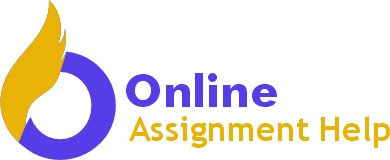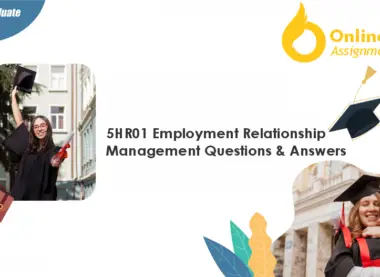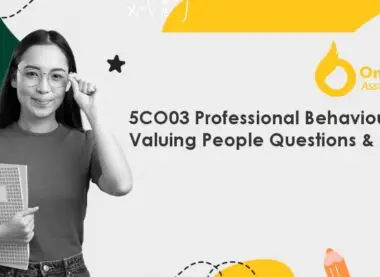| Learning outcomes: | Assessment criteria: |
|---|---|
| 1. Understand the purpose of an organisation and its operating environment | 1.1 Describe the purpose and goals of an organisation. 1.2 Describe the products, services and customers of an organisation 1.3 Analyse how external factors impact on the business activities of an organisation. |
| 2. Understand the structure, culture and functions of an organisation. | 2.1 Describe the structure of an organisation and the functions within it.
2.2 Explain how the different functions work together to optimise performance. 2.3 Explain how the culture of an organisation affects its operations. |
| 3. Understand how HR/L&D activities support an organisation. | 3.1 Describe how HR or L&D activities support an organisation’s strategy.
3.2 Explain the role of HR or L&D professionals in supporting line managers and their staff. |
Activity |
Assessment criteria |
| Your organisation has appointed a new manager. The HR department has been asked to produce information that will give the manager some understanding of the organisation prior to their start. You have been given creative licence to present the information in one of two ways;
1. A detailed presentation which includes slides and notes; or 2. A detailed information document. |
|
Whichever method you choose should include the following information: |
|
| A description of the purpose and goals of the organisation. | 1.1 |
| A description of the products and/or services the organisation offers. | 1.2 |
| A description of the main customers. | 1.2 |
| An analysis of four external factors and their impact on the business activities | 1.3 |
| A description of the organisational structure that includes a description of at least four functions. | 2.1 |
| An explanation of how these different functions work together within the organisation to optimise performance. | 2.2 |
| An identification of the culture of the organisation and explain two ways this affects operations. |
2.3 |
| Referring to three CIPD Professional areas, a description of three activities that the HR department would perform to help support the organisation. | 3.1 |
| An explanation of three ways in which HR could support both line managers and their staff. | 3.2 |
Evidence to be produced:A copy of a PowerPoint presentation slides with notes |
XYZ Ltd
-
1.1 A description of the purpose and goals of the organization.
XYZ Ltd operates in the women’s sports footwear, apparel, equipment and sports services industry. However, the company looks to branch out to include a plethora of categories of products and accessories such as men, women, and children sports shoes and apparel. Also, XYZ aims to offer various outdoor and recreational products. XYZ aims to be a global leader in the production and sale of both men and women sports footwear, apparel, equipment, and sports services. The company’s main purpose and goal is to attain and cement its status as the frontrunner in its industry, and to compete with renown brands such as Nike, Adidas, and Reebok.
- A description of the products and/or services the organization offers.
In the modern world, working out has become a major concern, especially due to lifestyle concerns that have been occasioned by diet choices, as well the contemporary employment needs. Consequently, the exercise and fitness industry has emerged as a profitable venture with the sale of work out products and services. The fashion industry has also made inroads into this sector, offering various products that are meant to improve the experience of the customer when working out in the gym as well as outdoor work outs such as jogging and stretching. While working out, one requires to operate in a safe and comfortable environment. In this regard, exercise shoes mark an important ingredient towards enabling a smooth work out experience.
XYZ’s women’s athletic shoes are meticulously designed and constructed to cater for the safety needs of customers. XYZ’s products target women of different ages and sizes. Also, their products are presented to the market in a range of colors, to cater to the diverse needs of the market. XYZ designs it shoes to also be won as part of an everyday casual outfit. The company further seeks the input of voluntary participants who are selected to review the product as a marketing strategy after the product is introduced in the market. Previous review reports indicate that XYZ’s are associated with comfort, informing XYZ’s philosophy of championing comfortability in shoes at affordable price points. XYZ’s shoes are revered for being light, in comparison to products from competing brands. Furthermore, XYZ’s shoes are sufficiently ventilated and a designed to include a thick sole cushion, offering the requisite support for heavy weight athletes. Also, XYZ diversifies its product designs to cater to customers with wide feet. The company tracks the opinions of customers vis a vis those of the product reviewers, with the purchasers’ opinions matching those of the reviewers in terms of comfort and product safety. Users across the board are especially pleased with the amount of cushioning in the shoe, given the lightness of the product.
1.2 A description of the main customers.
XYZ’s women’s athletic shoes are most popular amongst women whose fitness routine involves running and walking on surfaces such as pavements and roads. XYZ’s customers also comprise women who train on the treadmill as well as other areas around the gym. XYZ’s customer base also includes women undergoing physical therapy under the prescription of a physician. XYZ designs its shoes to target women from all walks of life, as its products can be worn as regular every-day life shoes. In this case, the company also implement a low-profile design in its shoes, allowing these shoes to be paired seamlessly with a plethora of outfits. Furthermore, the company targets a wide customer base by offering its shoes in various colorways. These shoes also designed to target customers who seek style as well as comfortable footwear at an affordable price tag. Therefore, XYZ’s customer base is mainly composed of middle-income women. Owing to their lightweight design, XYZ’s shoes are also popular among athletes of diverse calibers.
1.3 An analysis of four external factors and their impact on the business activities
The external business environment around the operations of XYZ can be assessed using a PEST (Political, Economic, Social, and Technological) analysis, as a business strategic planning instrument with which to conduct a thorough analysis of the company’s macro-environment. This analysis is instrumental in informing decision-making to ensure survival on the market at all times. Also, this tool’s application is vital as businesses operate under environments that change constantly.
Political
XYZ is primarily favored by favorable policies that foster the growth and stability of the organization, such as low-interest rates and well-structured international tax agreements. The company is prone to changes in tax and manufacturing laws, depending on the agenda of the government of the day. In this case, XYZ strives to expand its operations to countries with political stability, using these opportunities to expand its global reach. XYZ takes advantage of the current expansion of free trade policies to penetrate overseas markets. Here, XYZ borrows from Nike’s business model of working in countries where governments offer vital support; governments in developing countries where Nike has its operations have increased their infrastructural support providing Nike with an opportunity to expand its market reach in these countries (Wan et al., 2019).
Economic
Every organization must ensure that its economic model is designed to absorb shocks in the market in which it operates. In this regard, XYZ produces and sells reputable medium range products and thus, it is more shielded from economic shocks compared to other organizations. XYZ produces and sells affordable products from an average consumer’s point of view, but with a decent level of quality, cementing the organization’s place as a market front runner. To further protect itself from economic shocks, XYZ aims at taking advantage of low-cost labor in the far eastern countries, thus maximizing its profitability. XYZ possess significant resources that it can use to tap into small new and emerging markets, a move that could culminate in the expansion of the company’s global reach. Moreover, XYZ has over recent years boosted its profitability by reducing its energy consumption during production.
Social
Social factors can be described as cultural elements that are deemed to have a significant impact on a business, either positively or negatively. On the part of XYZ, these factors include leisure activities, lifestyle changes, demographics, and age structure. These factors share a direct link with market potential as well as the needs of customers. XYZ enjoys a smooth social environment, targeting athletes’ affinity for quality but affordable sporting shoes. Transitions in the needs and preferences of customers in terms of quality and affordability, along with lifestyle changes have accelerated the rate at which XYZ changes its products to suit the needs of its customer base. XYZ understands that the contemporary consumer not only chases quality items, but also affordability and availability.
Technological
Technological factors affecting a business comprise trends in the advancement of technology, which is a constant phenomenon in the contemporary business environment. Technology sparks the creation of new products as well as the phasing out of existing ones. For example, mobile technology birthed new business ventures for GSM carriers, while it spelled the phasing out of postal and courier businesses. In the case of XYZ, technology can be instrumental in reducing the company’s operational costs to a significant extent. In particular, XYZ has employed new technologies to produce ultra-light shoes to athletes and fitness enthusiasts at large. Also, XYZ has enjoyed improvements in terms of quality coupled with competitive advantage as a result of advancements in technology and technological diffusion in the manufacture of shoes. To derive the most from emerging technology, XYZ invests in the expertise of specialists in critical areas such as engineering design and exercise psychology. The company also reaches out to get the input of stakeholders such as trainers, coaches, and athletes, to identify areas that emerging technologies can address.
2.1 A description of the organizational structure that includes a description of at least four functions.
XYZ’s organizational structure is developed to provide for adjustments in coping with market differences. The organization serves as a prime example of how to factor regional variations into business strategies. XYZ’s organizational structure enables its business strategies to be regionalized, promoting value chains that precisely address customer expectations, particularly in the areas of marketing and service. The various attributes of XYZ’s corporate structure, give the company the requisite flexibility to cater to customer preferences with regard to athletic shoes and apparel in regional markets. This flexibility is particularly visible in how XYZ promotes its products through company owned stores. This framework is instrumental, coupled with XYZ’s organizational culture, in aiding the company navigate around the financial and business developmental impact brought about by competitors. XYZ is characterized by a geographic divisional organizational structure, based on XYZ’s global organization ambitions along with the uniqueness of regional market conditions. Functions in XYZ’s organizational structure include the global corporate leadership, semi-autonomous geographic divisions, global division for male products, and local stores.
2.2 An explanation of how these different functions work together within the organization to optimize performance.
XYZ has a global corporate leadership at its helm, which is made up of corporate managers who have offices at the company’s headquarters. These corporate managers are charged with making decisions on the company’s global structure. The global corporate leadership ensures that decisions are implemented throughout the organization. XYZ’s global operations are divided into segments (semi-autonomous geographic divisions) on the basis of regional markets. Here, each divisional manager is charged with optimizing operations in regional sporting shoes. The global division for male products is tasked with managing the male brand on a global scale as XYZ’s male products are not diversified as per global regions. The semi-autonomous geographic divisions and the global division for male products are further subdivided into stores, each promoting its products independently but under the guidelines laid down by the global corporate leadership.
2.3 An identification of the culture of the organization and explain two ways this affects operations.
A favorable public image makes massive positive additions to an organization’s brand, enabling the organization to maintain and expand its market share. With the advent of technology and ease of communication, messages of public health awareness are widespread, with the world moving towards healthier lifestyles amidst a plethora of health concerns (Park and Kincade, 2010). In this regard, XYZ has adopted a culture of embodying health living as a part of its brand, positioning itself as the solution to healthy lifestyle needs by offering not only safe but also affordable sporting apparel. As a move to successfully stay ahead of its competitors, XYZ constantly conveys its concerns for public safety by insisting that its products are produced with safety in mind, in a bid to facilitate favorable experiences for the consumers of its products. XYZ embodies the culture of embracing health awareness by seeking the input of voluntary participants who are selected to review the product as a marketing strategy after the product is introduced in the market. XYZ’s culture of embracing health awareness has culminated in increased trust in the company’s products, yielded increased customer loyalty. Furthermore, this business model has ensured that XYZ adapts to changing times, improving its status as a going concern.
3.1 Referring to three CIPD Professional areas, a description of three activities that the HR department would perform to help support the organization.
Resourcing and talent planning, learning and development, and performance and reward, form key CIPD Professional areas, under which the HR department must shape its activities.
Resourcing and talent planning
Resourcing and talent planning encompass coordination on the part of business and recruitment teams in areas such as forecasting the requisite resources, selecting an ideal hiring method, delivering resources when needed, and maintaining the talent pool for recruitment in the future. Important activities within resourcing and talent planning include recruitment, creating job descriptions, and selection. Recruitment forms a vital part of the process of staffing, under which the HR identifies and attracts competent applicants for employment. Staffing entails employing personnel of different kinds, both at the managerial and operative level. In fulfilling its staffing role, HR employs various approaches, keeping various positions occupied by the most ideal individuals. In creating job descriptions, HR lists all jobs within the organization as well as their location, after which HRM prepares a description for each job concerning physical specifications, behavioral specifications, mental specifications, and emotional specifications (Bailey et al., 2018). Selection entails choosing a subset of individuals from a pool of viable candidates for further assessment. The selection process is carried out by drawing parallels between the qualifications of applicants and the requirements of the job in question (Schalk et al., 2014).
Learning and development
Learning and development entails equipping employees with the requisite skills to operate in a constantly changing organizational environment, fulfilling the short and long-term goals of the organization. Under learning and development, HR plays an important role in increasing an employee’s capacity to perform well in a particular job through training and development. By offering training opportunities to employees, HR equips employees to better handle their current jobs as well as qualify for future opportunities (Schalk et al., 2014). In this case, important activities involve researching on emerging trends in training such as the use of zoom meetings to achieve remote learning activities, supervisory training to ensure a seamless for new employees, and accident training to ensure a safe working environment in general.
Performance and reward
Performance and reward, as a professional area, is meant to foster a high-performance environment and culture by facilitating initiatives that acknowledge and reward milestones, capabilities, and experience, ensuring that these initiatives are market-based, cost effective, and equitable. HR exists to provide for a healthy working environment, inspire commitment, and ensure employees are cared for (Schalk et al., 2014). Under performance and reward, HR may engage in activities such as establishing a system that motivates and appraises the staff based on performance, examining employee performance regularly based on information provided by line managers, and rewarding employees through increased pay, promotions, and bonuses. A performance-related pay system rewards hard work and yields a highly motivated workforce. Examining employee performance based on information from line managers may yield favoritism, hence necessitating additional measures such as employee ratings, objectives management, and group ranking (Analoui, 2017). Pay rises, promotions, and bonuses benefit the organization by achieving faster growth and expansion, minimized costs, competitive advantage, and increased productivity.
3.2 An explanation of three ways in which HR could support both line managers and their staff.
HR could offer support to both line managers and their staff through various ways such as communication practices, coaching and mentoring, and collaborative performance evaluation.
Communication Practices
HR exists to facilitate comprehensive and integrated information channels around an organization. In this respect, employees should have the ability to communicate freely with anyone in the organization, irrespective of hierarchy (Noe et al., 2017). When HR formulates open communication policies, it breaks away from structuring communication around organizational hierarchy (Bailey et al., 2018). In this regard, HR supports both line managers and their staff by creating open communication channels, revolutionizing how negotiations, meetings, supervision, and informal discussions are carried out.
Coaching and Mentoring
Coaching and mentoring can be described as development initiatives based on the employment of one-to-one conversations to improve the abilities, knowledge, or work performance of an individual. Coaching is aimed at achieving maximum efficiency and development on the job. It focuses on specific skills and goals although it can also influence the personal qualities of an individual such as socializing or confidence (Garvey et al., 2017). In this regard, through coaching and mentoring, HR supports both line managers and their staff by laying emphasis on each group’s specific roles in relation to the other, and identifying areas that each individual requires to improve.
Collaborative Performance Evaluation
Collaborative performance evaluation entails the use of information from line managers, by HR, to evaluate the performance of the staff. In this regard, HR is tasked with ensuring that the staff comprehend what is required of them by their line managers. Likewise, HR communicates to the line managers, as to the needs, strengths, and weaknesses of their staff. Using information from line managers as a method of appraisal may become a fertile ground for favoritism. To counter this problem, HR must cultivate fairness by incorporating other appraisal methods such as employee ratings, objectives management, and group ranking.
Reference List
Analoui, F., 2017. The changing patterns of human resource management. Routledge.
Bailey, C., Mankin, D., Kelliher, C. and Garavan, T., 2018. Strategic human resource management. Oxford University Press.
Garvey, R., Garvey, B., Stokes, P., & Megginson, D., 2017. Coaching and mentoring: Theory and practice. Sage.
Noe, R.A., Hollenbeck, J.R., Gerhart, B. and Wright, P.M., 2017. Human resource management: Gaining a competitive advantage. New York, NY: McGraw-Hill Education.
Park, H., and Kincade, D.H., 2010. Historical analysis of apparel marketer’s strategies: Evidence from a Nike case. Journal of Global Fashion Marketing, 1(3), pp.182-193.
Schalk, R., Timmerman, V., and Van den Heuvel, S., 2014. How strategic considerations influence decision making on e-HRM applications. Human Resource Management Review, 23(1), pp.84-92.
Wan, S., Petersen, C., & D., R., 2019, April 25. Crypto May Be Nike’s New Digital Business Strategy to Stay on Top. Retrieved from https://www.newsbtc.com/2019/04/25/crypto-may-be-nikes-new-digital-business-strategy-to-stay-on-top/.






